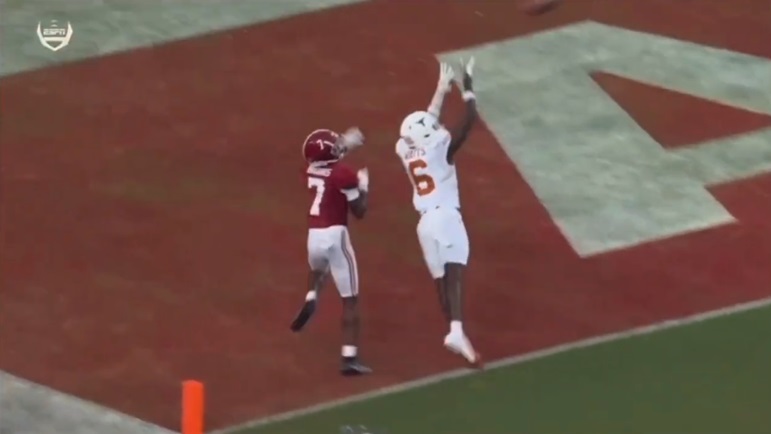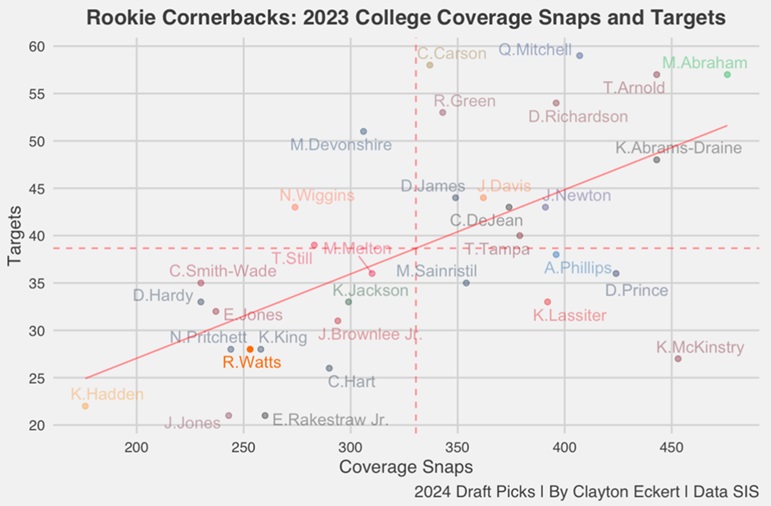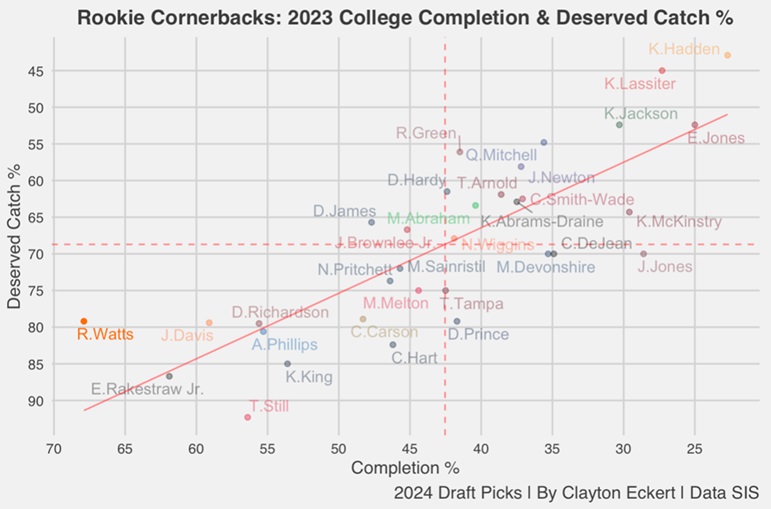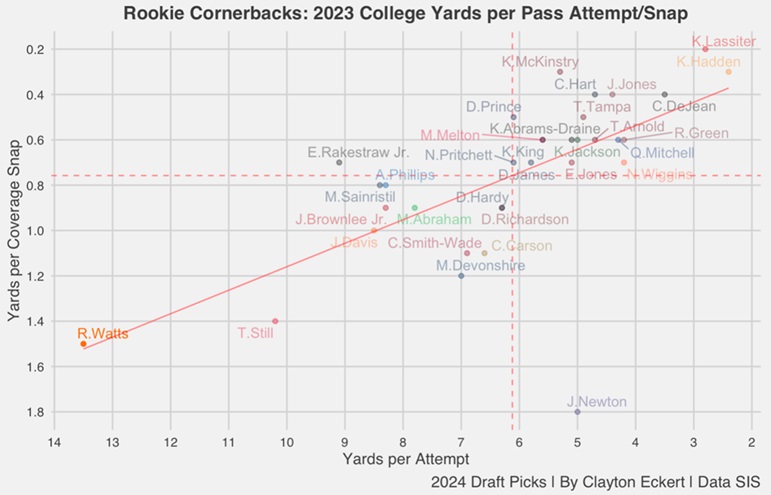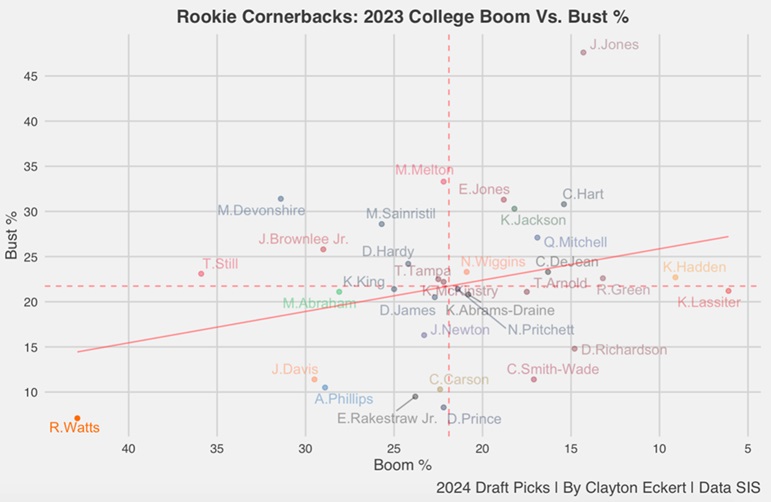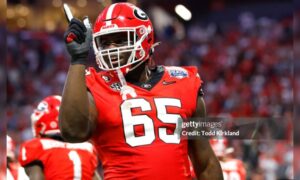Continuing the series, I wanted to move to the cornerback position where Pittsburgh selected Ryan Watts of Texas in the sixth round. Today’s goal is to look at and provide stat context for the position using Sports Info Solutions (SIS).
The data in this study looks at their final college season in 2023, focusing on the players who heard their names called in the draft. Two players were excluded because SIS does not track smaller schools or the Canadian Football League. The goal is to see how Watts stacked up among his peers.
First, let’s look at opportunities with coverage snaps and targets:
On the bottom left of the chart, we see Watts was well below average in both data points. He had 253 coverage snaps, which ranked 27th out of the 33 qualifying players. Notably, Watts suffered a hamstring injury mid-season, forcing him to miss three games.
On the fewer opportunities in 2023 compared to his peers, his 28 targets also landed low in the rankings, tying for 26th. This is all very important context as we dive deeper.
Now let’s begin to examine the quality of play with completion percentage and deserved catch percentage, which is the number of completions and drops divided by the number of catchable targets and passes defensed:
Watts lands on an unfortunate spot on the visual, starting with a dead-last rank in completion rate allowed (67.9). That number was six entire percentage points more than any other qualifier, a far cry from ideal.
Important context is how much man and zone is being played, along with snap alignments. The Longhorns employed Watts in zone coverage 64.6 percent, compared to just 18.5 percent in man coverage, and played outside corner primarily (84 percent).
So, opposing receivers had an easier time at the catch point against Texas’s zone-heavy coverage scheme, which impacts Watts’ numbers. He fared a bit better in deserved catch rate at 79.2, tying for 25th. Being above the trendline (diagonal line) in deserved catch rate points to some positive context for his poor completion percentage.
Of Ryan Watts’ 28 targets, 24 were catchable, and he allowed 19 completions. This makes sense, considering the high amount of zone coverage he was in. Watts did provide three passes defensed, with his stellar arm length showing up in game, and was a primary factor in landing better in the deserved numbers.
The other side of that coin was zero interceptions and a dropped interception. Pittsburgh has improved in the takeaway department as of late and can hopefully rub off on Watts to get some of these game-altering plays if he earns playing time.
Next, let’s look at the depth of targets with yards per attempt and yards per coverage snap:
Once again, Watts lands on the bottom left of the visual. This time, he looks very lonely there, with most qualifiers having much stronger results. Another dead-last ranking, too, with a 13.5 yards per attempt result. 379 yards allowed, to be exact, is the most of any Texas defender last season despite missing three games. Watts’ 1.5 yards per coverage snap also ranked terribly at 32nd.
It’s not what I was expecting or wanting to learn, of course, and it points to Ryan Watts being a work in progress in coverage, to say the least. Hopefully, Pittsburgh can mold his avatar physique into better on-field contributions than his final college season.
Another stat often used to evaluate defenders in coverage is QBR Against, so let’s see how they fare along with Points Saved Per Play (PSPP), which is the total of a player’s EPA responsibility while in coverage using the Total Points system that distributes credit among all players on the field for a given play (with positive numbers being good).
Totals are scaled up to map to the average points scored or allowed on a team level, with the player’s snap count determining how much to adjust. For pass defenders, this includes accounting for pass rush, broken tackles, dropped interceptions, turnovers, and turnover returns. Values are modulated using a quality-of-competition multiplier based on each opponent’s previous year of performance:
As you probably expected after the previous views, the reoccurring theme of being below average unfortunately continues for Watts. He also ranked dead last in more data points, including both in this view.
Ryan Watts posted a 122.6 QBR against, compared to 107.4, being the second worst, and the mean of drafted quarterbacks landing around 60.0. Similarly, his 0.013 PSPP bottomed the rankings, with a 0.024 number next worst and an average of around 0.09. Ouch.
To close, let’s look at boom and bust percentages from SIS to see how the cornerbacks performed on extreme end of the spectrum plays:
- Boom % = The percentage of dropbacks that resulted in an Expected Points Added (EPA) of 1 or more (a very successful play for the offense)
- Bust % = The percentage of dropbacks that resulted in an EPA of -1 or less (a very unsuccessful play for the offense)
You guessed it. Ryan Watts lands on the extreme lower left with dead-last rankings. Apologies for sounding like a broken record and the bearer of this bad news. More specifically, he had a horrid 42.9 boom rate, seven percentage points lower than any other qualifier.
To find some silver lining, he allowed just one touchdown, which I thought would be much worse given this data. Also, the bust percentage results were more tightly grouped, with Watts’ 7.1 number just over a percentage point lower than the second-worst.
Our Alex Kozora released a film study on what impresses him about Ryan Watts, including size, press ability, length, and fluidity. The study included a great rep that displayed those abilities for a great pass breakup in the end zone. There is definitely potential, and Pittsburgh is betting on themselves to coach up these traits they value at outside corner and hopefully maximize what he can become in the NFL.
Unfortunately, Ryan Watts was below average in every aspect of today’s coverage study though. Out of the 33 qualifying drafted cornerbacks, here is a wrap-up of his rankings: deserved catch rate (T-25th), targets (T-26th), coverage snaps (27th), yards per coverage snap (32nd). On top of that, he was dead last in more data points than not, including completion rate, yards per attempt, QBR against, points saved per play, boom rate, and bust rate.
It’s painful information to stomach, but some factors, such as the mid-season hamstring injury or high zone coverage usage, can impact the numbers. While this is true, it, of course, isn’t limited to Watts, with the majority of his peers faring better in coverage in 2023. We also see specific context to the narrative from several in the pre-draft process, projecting a move to safety as being imminent, which will be interesting to monitor as a potential fallback plan.
Here’s to hoping Pittsburgh made a good decision and things pan out well for Ryan Watts in his rookie season (and beyond) for the black and gold. Can’t wait to see it play out.

